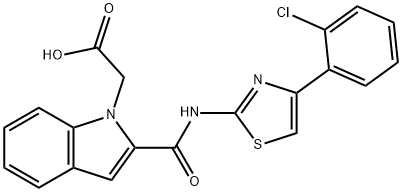136381-85-6
 136381-85-6 结构式
136381-85-6 结构式
基本信息
SR 27897 hydrate
{2-[4-(2-Chloro-phenyl)-thiazol-2-ylcarbamoyl]-indol-1-yl}-acetic acid
2-[[[4-(2-Chlorophenyl)-2-thiazolyl]amino]carbonyl]-1H-indole-1-aceticacid
1H-Indole-1-acetic acid,2-[[[4-(2-chlorophenyl)-2-thiazolyl]amino]carbonyl]-
2-[[[4-(2-chlorophenyl)-2-thiazolyl]amino]carbonyl]-1H-indole-1-acetic acid hydrate
物理化学性质
常见问题列表
EC50: 6 nM (cholecystokinin (CCK1) receptor); Ki: 0.2 nM (cholecystokinin (CCK1) receptor)
In vitro, Lintitript (SR 27897) is a competitive antagonist of cholecystokinin (CCK)-stimulated amylase release in isolated rat pancreatic acini (pA
2
= 7.50) and of CCK-induced guinea pig gall bladder contractions (pA
2
= 9.57).
Lintitript produces concentration dependent inhibition of [
125
I]CCK binding to CCK1 receptor sites in the rat pancreas (IC
50
value of 0.58 nM) and also to CCK 2 sites in the guinea pig cortex (IC
2
value of 479 nM). Lintitript inhibits [
125
I]gastrin binding to gastrin receptors. Lintitript (0.5 nM) increases the dissociation constant of CCK for the CCK A receptor (K
d
= 1.8 to 7.2 nM) without modifying the maximum number of receptors (B
max
= 1800 to 1770 fmol/mg).
Lintitript (SR 27897; 1 mg/kg, i.v.) completely reverses the CCK-induced amylase secretion. Lintitript also inhibits CCK-induced gastric and gallbladder emptying in mice (ED 50 s = 3 and 72 μg/kg, respectively). Lintitript is also very active (ED 50 = 27 μg/kg p.o.) in the gall bladder emptying protocol with egg yolk as an inducer of endogenous CCK release.

